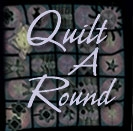
I've been enjoying the photos of snow-dyed fabrics from various quilters on the Artquilt list and just had to try it myself!
My results, however, are not as fabulous as those others have created. The bin above produced the fabric in the photo above and the two immediately below.
It's OK, but not as dramatic as I had hoped—and this is the better of the two bins.
This does NOT mean I am defeated, though. This was merely the first trial. Maybe the snow layer was too thick. There was a lot of liquid in the bin after the snow finally melted.
The second bin (above) had two shades of blue and two green.
This is the piece of fabric from that bin. There is a lot of space with little or nothing on it.
I really do like this texture, but it's like a little island in the ocean. Only an occasional spot of color.
One artist did the dyeing on a screen, rather than in a bin, so the fabric didn't sit in liquid. Maybe that's the secret.
Any suggestions?

















11 comments:
Your pieces turned out nice but it looks like you put the fabric in the bins and add snow ontop. What I do is raise my fabric up on a piece of plexi glass or a wire rack then put the snow and dye on either by mixing the dye into the snow or placing on top. I mix my snow in. My blog is http://judiscrazyworld.blogspot.com I wrote the article for the Quilting Arts magazine last Nov/Dec you can also find a great tutorial over at http://bunks.wordpress.com/ have fun.
Beth, Judi's method might work better with the Earth Safe Finishes, but I'm thinking that concentration might be the problem. I use a much higher dye concentration when I snow dye than usual to deal with the dilution factor of the snow. I'd not call these a failure - just add to them and you'll have something fabulous, I'm sure!
Just from a novice's point of view - it looks like dilution in the dye vs. snow. But I would take these and build upon them like Beth said. Love the idea!
Beth, I'm using old window screens to hold the cloth up out the liquid, but old meat racks or cooling racks would work too. I'm not familiar with the Earth Safe dyes, but with the the MX dyes, I'm mixing them up very strong.
Someone else had mentioned that they had problems with the turquoise being fugitive, because it requires warmer temps, so I've been letting mine batch overnight near the furnace and it seems to help all the colors.
Have fun!
Thank you all for your suggestions. I'm eagerly waiting for the next snowfall!!
Thanks for sharing your process Beth, and your pictures. This morning I also have cried, "Uncle", ordered my pfd fabric, my dyes, etc, and cannot wait to give it a go!!
While you're waiting for the next snow, try ice-dyeing. I pre-soak my fabric, scrunch in a small container, stick it in the freezer for about an hour, then apply my dyes and let batch for about 5-6 hours. I get great color, and wonderful markings that way!
I think your results are beautiful and unusual, almost ethereal. It looks to me like not enough dye -- when I did mine, the whole top of the snow was colored. I mixed up 3 cups of dyes, fairly concentrated, and used all of that in 4 bins, each with a FQ or slightly larger piece of fabric. The layer of snow on top of the fabric was maybe 4" thick.
Hi Beth,
No need to wait for snow-we used an ice grinder here in San Diego:)
Your pieces turned out exactly like my first batch did, somewhat pale and undefined. My 2nd attempt turned the samples almost entirely lavender with a few striations of other colors. I put the fabric in, then snow, then color and it looks like that is not the best way.
Post a Comment